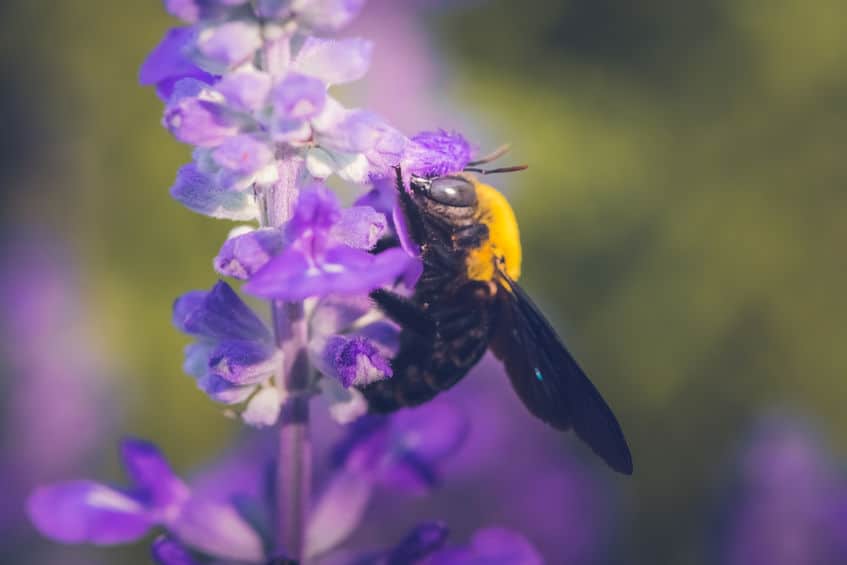Where are are carpenter bees found?
They live all across North America. Bees belonging to the genus Xylocopa are known as large carpenter bees, and there are over 500 different species around the world, with several species covering North America. The eastern carpenter bee, Xylocopa virginica, covers much of the eastern and mid-United States, as well as southern Ontario.
Do carpenter bees build hives?
They don’t build hives. Rather than building nests out of wax-like honeybees, eastern carpenter bees will burrow through wood to create their nests. The word Xylocopa even comes from the Ancient Greek xylocopos, meaning “wood-cutter”. The nests consist of an entrance passage with tunnels leading off at right angles, like a hallway with several rooms. In these tunnels, the females will lay an egg, leave a store of pollen and nectar for the larvae to consume, and then seal it off with bits of wood. The process is repeated until the tunnel is filled with these chambers, often 6 to 8 in a single tunnel, and then she will move on to the next one. (source)
Do carpenter bees like nectar?
They are nectar robbers. Plants tend to produce nectar deep at the base of flowers so that when pollinating creatures such as bees, hummingbirds, and even bats go to feed off the nectar, they fly off to the next flower covered in pollen. Although pollen is also a food source for bees, their hairy bodies transmit enough of it between flowers to aid in the pollination process. Carpenter bees can be mischievous though; rather than diving face-first into the flower, they sometimes chew their way through the base to access the nectar-producing glands and drink their fill. (source)

Do carpenter bees make honey?
They don’t make honey. Bees are often associated with honey, but the vast majority of bees don’t actually produce honey at all, and the eastern carpenter bee is no different. More than half the species of bees across the world are solitary bees, where either a single bee or a few bees working together will mate with the males, lay eggs, and then die. Turning nectar into honey is a process that requires a lot of bees and a lot of effort, things that solitary bees do not have the luxury of.
Do carpenter bees have a queen?
They don’t have a queen. The purpose of a queen bee in a hive is to be the sole egg-layer, with worker bees collecting materials for the nest and tending to the larvae. While the eastern carpenter bee lacks a queen, they will congregate with other bees; they usually build nests alongside one another to help defend the young from predators such as woodpeckers. Female bees will only tend to their own larvae, but males will band together to defend the nest as a whole (source). When the adult bees finally emerge from their nests in August, they will forage and feed before returning back to their chambers to hibernate, and then mate in the spring. Some species of native bees will only last a few weeks; long enough to lay eggs and then die. Individual eastern carpenter bees can live for two under optimal conditions.
Are carpenter bees aggressive?
Although the size of these bees can be intimidating, they are not known to sting unless provoked or aggressively handled. The stinger on female bees is not barbed, so she is able to sting multiple times. Males, on the other hand, don’t have a stinger at all. When defending the hive, the male may act aggressively and fly into the intruder’s face, but he is unable to do any actual harm.
How can you tell carpenter bees apart from bumblebees?
Many species of carpenter bee are large in size and may resemble bumblebees (Bombus sp.), but the eastern carpenter bee has a distinct defining trait: a metallic hairless abdomen (source). Bumblebees vary in color combinations based on the specific species, but they always have hairy bums. Another common trait between the two is the way in which they pollinate; by grabbing hold of the flower and vibrating to dislodge pollen. Also, the thorax on the eastern carpenter bee is covered in yellow hair, with a small bald patch right in the center. Male bees are also distinct, as they have longer bodies than females and a white spot on their face.
Do carpenter bees reuse nests?
Their nests are often second-hand. Imagine building your house from scratch every time you moved. It’s an arduous, demanding process. The eastern carpenter bee would most certainly agree with you, as they expend a large amount of precious energy burrowing in wood to make the tunnels for their brood. As such, bees try to look for old nests that have been created by other bees and will inhabit those. When several bees are living in the same nest, the tunnels can be up to three meters in length.
Do carpenter bees pollinate?
They’re great pollinators. Aside from the usual flowers in the garden, eastern carpenter bees are also beneficial for crop pollination. Studies have been conducted with the use of these bees in greenhouses, and have found them to be quite productive, even in small numbers. This provides the potential for carpenter bees to be used in horticulture operations. (source)
Are carpenter bees considered pests?
The eastern carpenter bee is a docile pollinator, but their burrowing habit has many people calling pest control to remove or prevent them from forming nests in manmade wooden structures. The tunnels they dig can impact the structural integrity, but an easy solution exists. Eastern carpenter bees prefer untreated, unpainted wood. By coating your wooden structures in varnish or paint, the bees are more likely to go elsewhere in search of a potential nesting site. Additionally, you can take it a step further by leaving out pieces of untreated wood away from where human activities tend to take place, and in doing so help promote habitats for native bees.
